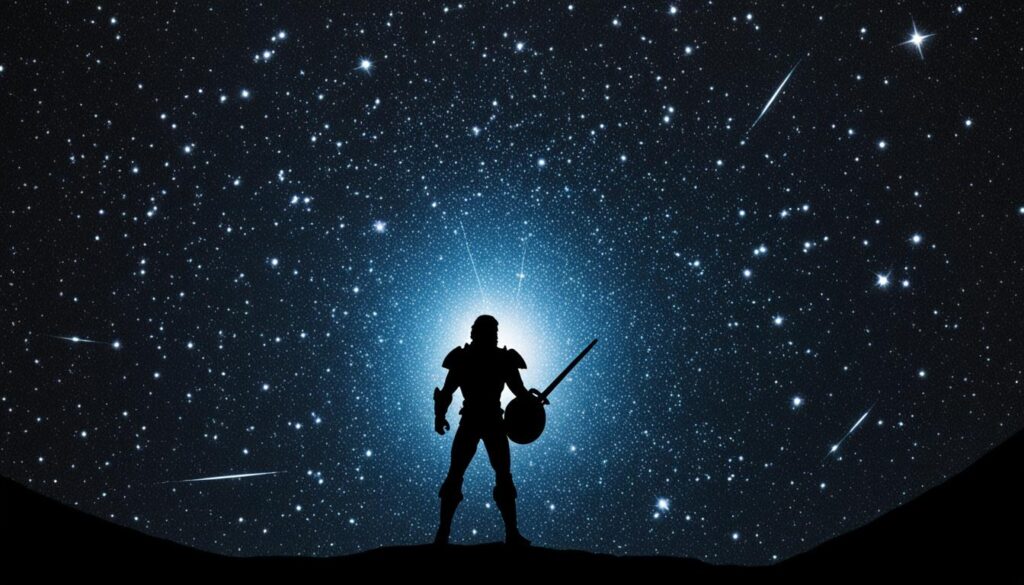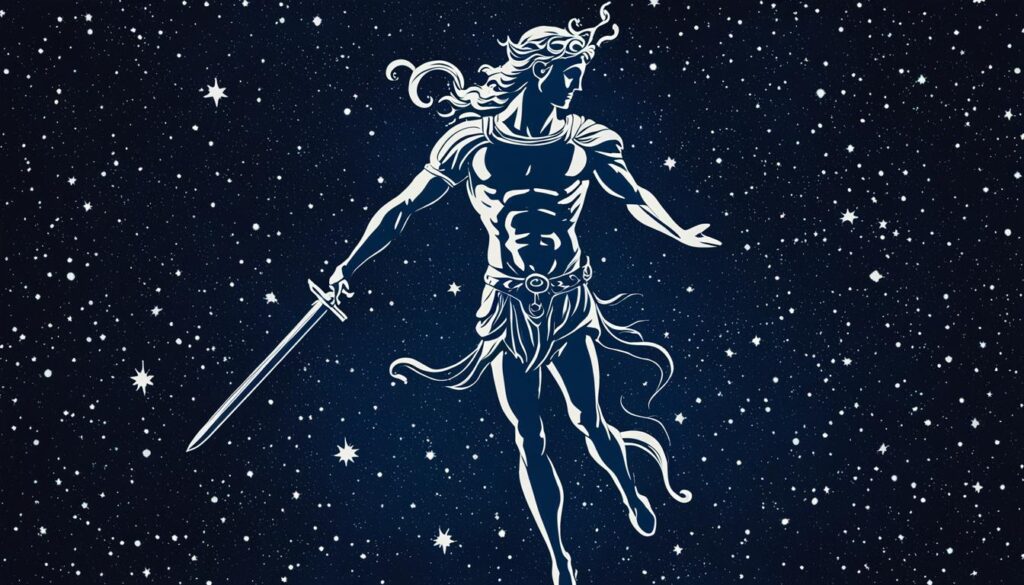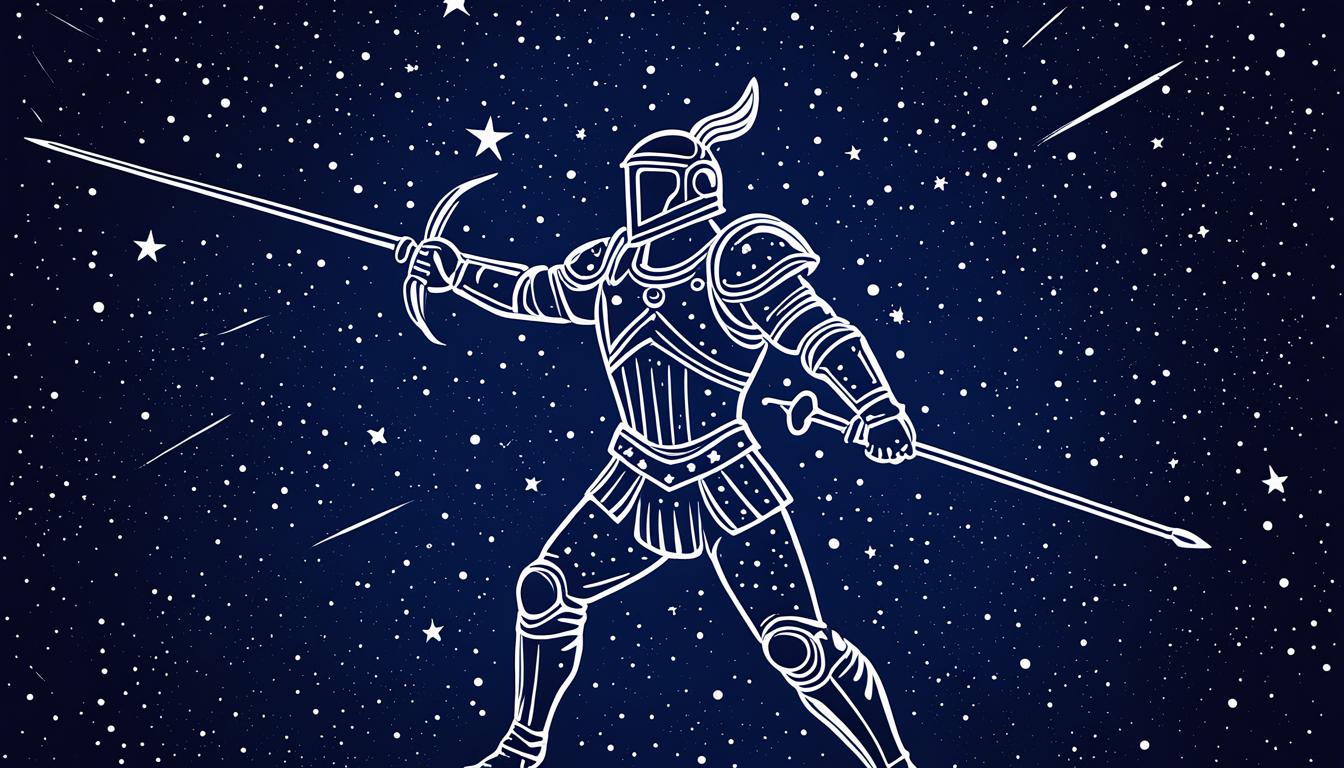| Genitive | |
| Abbreviation | |
| Pronunciation | |
| Main Stars | |
| Brightest Star | |
| Right Ascension | |
| Declination | |
| Sq. Deg. Area | |
| Crosses Meridian | |
| Visible Lat. Range |
As you gaze into the northern celestial dome, the Constellation Perseus emerges as a stellar tapestry rich in mythology and studded with cosmic treasures. This ancient constellation, nestled next to the majestic Andromeda, encompasses an expanse of 615 square degrees—an astronomical canvas that paints the timeless heroics of the Greek hero Perseus. For centuries, skywatchers and astronomers alike have been captivated by the Perseus constellation facts, which delineate its place as the 24th largest pattern in the sky and its prime visibility in December at the precise hour of 9 p.m.
As you delve into Perseus constellation information, you will discover a family of constellations steeped in mythological significance, from Pegasus to Cassiopeia. The constellation’s historical roots trace back to Ptolemy’s documentation in the 2nd century, offering you a glimpse into the celestial lore of bygone eras. The celestial objects in Perseus are a dazzling assortment, featuring the Perseid meteor showers, deep-sky magnificence such as Messier 34, the Double Cluster, and nebulae that evoke the grandeur of the cosmos.
Key Takeaways
- Discover the 24th largest constellation, Perseus, an astronomical spectacle best viewed in December.
- Explore the Perseus family of constellations that includes other prominent figures like Andromeda and Pegasus.
- Uncover the ancient origins of the Perseus constellation, reaching back to the cataloging by Ptolemy.
- Experience the wonder of the Perseid meteor showers and deep-sky jewels such as the Little Dumbbell Nebula.
- Embark on a journey through Perseus’ 615 square degrees of celestial narrative and night-sky allure.
Unveiling Constellation Perseus: An Astronomical Marvel
As you gaze upon the night sky, the constellation of Perseus beckons with its array of stars that have captivated observers for millennia. Situated in the northern celestial hemisphere, Perseus is a showcase of astronomical history and myth, bordered by Aries, Taurus, Auriga, Camelopardalis, Cassiopeia, and Triangulum.
A Brief Overview
The Perseus constellation, with a quadrant designation of NQ1 and pronounced as /ˈpɜːrsiəs/, holds within its expanse 19 main stars forming the visual spectacle known as the Segment of Perseus. This star pattern, reminiscent of ancient lore, is anchored by the orange supergiant Miram (Eta Persei), with a cohort of stars such as Gamma Persei, Mirfak (Alpha Persei), Sigma, Psi, and Delta Persei enhancing its celestial narrative.
Understanding the Stars in Perseus
When you explore the Perseus constellation map, you’ll find numerous luminaries that compose the striking image of this ancient hero. Alpha Persei, or Mirfak, the constellation’s brightest star, illuminates the Perseus star cluster with a magnitude of 1.79. Its brilliance is surpassed only by the fascinating characteristics of Beta Persei, known as Algol or the “Demon Star,” an eclipsing binary star distinguished by its rhythmic change in luminosity.
Mirfak’s position within the Alpha Persei Cluster, a stellar nursery of space, showcases its high luminosity and significant mass when compared to our Sun. The stars in Perseus not only light up the night but also hold an allure for astronomers with their planetary systems. Six stars in this mythological assembly invite intrigue as they host planets, while meteor showers like the Perseids and the September Perseids provide an annual spectacle for stargazers worldwide.
| Star Name | Designation | Magnitude | Notable Features |
|---|---|---|---|
| Miram (Eta Persei) | Eta | 3.76 | Orange supergiant leading the Segment of Perseus |
| Mirfak (Alpha Persei) | Alpha | 1.79 | Brilliant star within the Alpha Persei Cluster |
| Algol (Beta Persei) | Beta | 2.12 | Eclipsing binary system with variable brightness |
| Gamma Persei | Gamma | 2.93 | A part of the curved Segment of Perseus pattern |
Lose yourself in the splendor of the Perseus constellation as you connect with the stories of old, using today’s technology to unravel the secrets of these celestial beacons. With each star in Perseus, a piece of the astronomical puzzle falls into place, making your stargazing journey both enlightening and enchanting.
Stellar Giants and Magnificent Clusters: Key Features of Perseus
As an enthusiast of the night sky, you’re no doubt familiar with the many celestial objects in Perseus, a constellation that dazzles with its array of stellar phenomena. This region of space is a treasure trove of cosmic wonders, housing not only the stars in Perseus but also some of the most recognisable clusters within our sight.
Take the Perseus star cluster, for instance, also known as Messier 34 or M34. This youthful and sprawling open cluster can be easily admired through a simple pair of binoculars. M34 offers you a glance at celestial dynamics in a condensed space, wherein groupings of stars form an assembly that’s both scientifically fascinating and visually arresting. It’s a stark reminder of the grand scale and beauty of our universe and a highlight among the celestial objects in Perseus.

Another crowning jewel of Perseus is the famous Double Cluster, known to ancient astronomers and still captivating to us today. This pair of open star clusters, NGC 869 and NGC 884, situate closely in space and are often considered together due to their proximity in the night sky. This celestial duo is easily a showstopper with their combined brilliance, adding to the rich tapestry of Perseus constellation facts.
Adding depth to the narrative of the cosmos in this sector, the expansive Perseus Arm of the Milky Way Galaxy flows elegantly through this constellation. It’s a larger cosmic structure that serves as the galactic “backbone,” enriching the surrounding space with a density of stars and various interstellar materials.
Moreover, Perseus hosts another Messier object, M76, commonly referred to as the Little Dumbbell Nebula. Appearing as a celestial smudge through small telescopes, it is an example of a planetary nebula, representing the final blooming phase of a sun-like star’s life cycle. Observing it is like capturing a moment of cosmic transcendence—another reminder of why the stars in Perseus entice skygazers and astronomers alike.
In your starry ventures, these fascinating celestial bodies provide a glimpse into the formative and evolving aspects of our universe. Each object in the Perseus constellation carries with it a story of stellar birth, evolution, and eventual demise, echoing across the eons to reach your telescope’s lens. So the next time you set your sights upwards, pause to ponder the lives of these distant suns and the cosmic dance they’ve performed for countless millennia.
Exploring Perseus Mythology: The Legendary Hero of the Stars
As you gaze upon the night sky, the constellations tell stories of ancient heroes and their epic tales. One such narrative is that of Perseus, steeped in rich Perseus mythology and visible through the Perseus constellation stars. This constellation not only brings to life the legacy of its eponymous hero but serves as a historical archive, mapping Perseus constellation history across the cosmos.

The Myth of Perseus and Medusa
A seminal figure in Greek legend, Perseus’ most notable exploit was his victory over Medusa, the Gorgon with serpentine locks whose very look could petrify. This monumental event is immortalized in the skies, as the constellation artfully positions the star Algol, representing Medusa’s menacing eye, that pulsates with light, mimicking her legendary, petrifying gaze.
Adjacent Constellations and Their Mythological Links
The mythological universe around Perseus extends beyond his personal saga to encompass a pantheon of related constellations. Like a celestial play, the sky around Perseus reveals characters from his myth, each with their own adjacent constellations. Below is a table that connects these legendary figures with the corresponding celestial patterns.
| Constellation | Mythological Figure | Relation to Perseus |
|---|---|---|
| Andromeda | Princess Andromeda | Perseus’ Damsel, Rescued and Wed |
| Cetus | Sea Monster | Vanquished Foe |
| Cassiopeia | Queen Cassiopeia | Andromeda’s Mother, Consort of Cepheus |
| Cepheus | King Cepheus | Father of Andromeda |
| Pegasus | Winged Horse | Symbolic Offspring of Medusa |
Awareness of these sky-bound stories not only enhances your stargazing experience but invites you to partake in the rich tapestry of ancient narratives that have been shared for generations. Next time you observe the constellation Perseus, remember that you are looking at more than just stars – you are witnessing the immortalization of one of mythology’s greatest heroes.
Navigating the Night Sky: How to Locate the Constellation Perseus
Embarking on a celestial journey to discover the Perseus constellation can be a gratifying experience for both novice stargazers and seasoned astronomers. To commence your search for Perseus in the vast night sky, you’ll want to look for its more prominent neighbors as reference points. The constellation lies in a rich Milky Way field, flanked by the well-known Cassiopeia and Andromeda constellations. By identifying the distinctive W shape of Cassiopeia and following its pointer stars, you create an imaginary line that leads you directly to the brilliant star Mirfak, also known as Alpha Persei, the luminary of Perseus.
As you refine your stargazing skills, using a Perseus constellation map can be incredibly helpful in distinguishing the stars in Perseus. Once you have located Mirfak, allow your gaze to drift to the nearby dazzling array of the Pleiades and the commanding presence of Auriga, which serve as additional guides in the celestial tapestry. The unique shape of the Perseus constellation, featuring the captivating curve of the Segment of Perseus, manifests as a memorable pattern that can be readily spotted in the night sky.
With your newfound knowledge on how to find Perseus, your adventures under the stars are bound to be filled with excitement and discovery. Remember, the most ideal time to view the Perseus constellation stars is on a clear night, preferably away from the blinding lights of urban areas. Armed with patience and curiosity, let the cosmos unveil its stories as you trace the paths the ancients once followed, connecting dots in the eternal vault of heaven.
FAQ
What is the Perseus constellation and where is it located?
The Perseus constellation is a group of stars named after the Greek hero Perseus, located in the northern sky. It is situated adjacent to the Andromeda constellation and is part of the Perseus family, which includes other mythologically significant constellations. It lies between latitudes +90° and -35° and is best viewed in December around 9 p.m.
What are the most notable celestial objects in the Perseus constellation?
The Perseus constellation is rich with celestial objects, including the famous Perseid meteor shower, the California Nebula, Messier 34 (a visible open star cluster), the Double Cluster (two closely positioned open star clusters), and the Little Dumbbell Nebula (Messier 76). It also hosts a number of stars with planetary systems.
Can you tell me about the mythology associated with the Perseus constellation?
The mythology of the Perseus constellation comes from the adventures of the Greek hero Perseus, son of Danaë and Zeus. He is known for slaying Medusa, the gorgon with a gaze that turned people to stone, and rescuing Andromeda from a sea monster. The constellation symbolically represents Perseus holding Medusa’s head, with Algol (Beta Persei) depicting her eye.
How can I find the Perseus constellation in the night sky?
To find the Perseus constellation, look for Cassiopeia’s distinct ‘W’ shape in the night sky. Extend an imaginary line from this shape towards the Pleiades to locate Mirfak, the brightest star in Perseus. Also, tracing the line of Andromeda’s brightest stars can lead you to Mirfak. Look for the curved pattern known as the Segment of Perseus to identify the rest of the constellation.
What are the brightest stars in the Perseus constellation?
The brightest star in Perseus is Alpha Persei, also known as Mirfak, with an apparent magnitude of 1.79. The second-brightest star, Beta Persei, is commonly known as Algol or the “Demon Star,” famous for its periodic brightness variations due to it being an eclipsing binary system. Gamma Persei is another bright star in this constellation.
What is unique about the star Algol in the Perseus constellation?
Algol, known as the “Demon Star,” is interesting due to its nature as an eclipsing binary star system. It has regular dips in brightness that were observed and recorded since ancient times. These changes occur as a larger, dimmer star passes in front of a brighter one, causing the apparent brightness to decrease from Earth’s perspective.
Are there any meteor showers associated with the Perseus constellation?
Yes, the Perseid meteor shower, one of the most well-known meteor showers, is associated with the Perseus constellation. It occurs annually from mid-July to late August when Earth passes through the debris left by Comet Swift-Tuttle. The September Perseids is a separate, lesser-known meteor shower also originating from this constellation.
What is the significance of the Perseus constellation in astronomy?
In astronomy, the Perseus constellation is significant due to its rich assortment of celestial phenomena and its role in ancient mythologies. It serves as a guidepost for locating other constellations and hosts parts of the Perseus Arm of the Milky Way. Its various deep-sky objects and meteor showers provide exciting observation opportunities for astronomers and stargazers alike.
How are the Perseus and Andromeda constellations related in terms of mythology?
The Perseus constellation is mythologically linked to the Andromeda constellation through the story of Perseus rescuing Andromeda from a sea monster. After defeating Medusa and using her head to save Andromeda, Perseus marries her. Their story is captured in the stars with Andromeda’s constellation positioned near Perseus in the sky, continuing the celestial representation of the myth.
What are some tips for beginners who want to observe the Perseus constellation?
Beginners interested in observing the Perseus constellation should start by looking for it during its peak visibility in December. Using a star map or mobile astronomy app can assist in locating Perseus through its surrounding constellations. Binoculars can enhance the viewing experience, especially for observing the Messier objects and star clusters within it.






